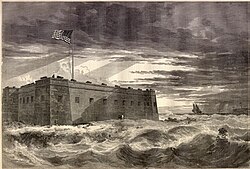Battle of Santa Rosa Island
| Battle of Santa Rosa Island | |||||||
|---|---|---|---|---|---|---|---|
| Part of the American Civil War | |||||||
 Fort Pickens, the site of the Battle of Santa Rosa Island | |||||||
| |||||||
| Belligerents | |||||||
|
|
| ||||||
| Commanders and leaders | |||||||
| Harvey Brown | Richard H. Anderson | ||||||
| Strength | |||||||
| 600 | 1,200 | ||||||
| Casualties and losses | |||||||
|
67 total 14 killed 29 wounded 24 captured or missing |
87 total 30–40 killed | ||||||


The Battle of Santa Rosa Island (October 9, 1861) was an unsuccessful Confederate attempt to take Union-held Fort Pickens on Santa Rosa Island, Florida.
Background
[edit]Santa Rosa Island is a 40-mile barrier island in the U.S. state of Florida, thirty miles from the Alabama state border. At the western end stands Fort Pickens, which in the first week of January 1861 had a garrison of only one company, Company G of the 1st Regiment, US Artillery. The fort was commanded by Major John H. Winder, a secessionist who would have likely turned the fort over to the rebel government. Instead, Winder and his senior lieutenant were absent from the fort and so the garrison was commanded by Lieutenant Adam J. Slemmer. Slemmer immediately began to collect armaments from the nearby military posts and prepared to hold out against the growing rebellion.[a][1]
By the fall of 1861, it was reinforced by more men from the 1st, as well as the 2nd and 5th U. S. artillery, and the 3rd U.S. Infantry, under command of Col. Harvey Brown, of the 5th artillery. The 6th New York Volunteer Infantry, commanded by Col. William Wilson, was encamped outside the fort, a short distance east of it.[2]
Battle
[edit]After midnight on October 9, Brig. Gen. Richard Anderson crossed from the mainland to Santa Rosa Island with 1,200 men in two small steamers to surprise the Union troops at Camp Brown and if possible capture Fort Pickens. He landed on the north beach about four miles east of Fort Pickens and divided his command into three columns. After proceeding about three miles, the Confederates surprised the 6th Regiment, New York Volunteers, in Camp Brown and routed the regiment. Gen. Anderson then adopted a defensive stance to entice the Federals to leave the fort and attack. Receiving reinforcements, Col. Harvey Brown sallied against the Confederates, who reembarked and returned to the mainland.
The Union loss was 14 killed, 29 wounded and 24 captured or missing. General Braxton Bragg and Lieutenant Hamel, commanding the Confederate forces at Pensacola, reported their loss as "30 or 40 killed and wounded," but an undocumented Confederate newspaper, found by Lieut. Seeley a few days after the occurrence, gave the total casualties as 175. This claim was likely an exaggeration. Maj. Israel Vogdes, of the 1st artillery, was captured, and on the Confederate side Gen. Anderson was severely wounded. The camp of the 6th N.Y., which was the main objective of the raid, was largely destroyed, meaning the raid could be deemed a success.
Fort Pickens and the battle site are preserved within the Gulf Islands National Seashore.[3]
Order of battle
[edit]This section needs additional citations for verification. (August 2007) |
Union Forces
[edit]Department of Florida: Col. Harvey Brown
- 6th New York Zouave Infantry, Col. William Wilson[4]
- Company C – Captain R. H. Hazeltine
- Company D – Captain Duffy
- Company F – Lieutenant Jacob Silloway
- Company H – Captain Charles E. Heuberer
- Company K – Captain H.L. Hoelzle[5]
- Vodges' Command – Major Israel Vogdes (c), Capt. John McL. Hildt
- Company A, 1st Artillery – Lieutenant Frank E. Taylor
- Company E, 3rd Infantry – Captain John McL. Hildt
- Company G, 6th New York Zouave Infantry – Captain James H. Dobie
- Arnold’s Command – Major Lewis Golding Arnold
- Company C, 3rd Infantry – Lieutenant Alexander Shipley
- Company H, 2nd Artillery – Captain James M. Robertson
Confederate Forces
[edit]Brig. Gen. Richard Heron Anderson
- Demolition Team – Lieutenant James H. Hallonquist
- 1st Battalion – Colonel James R. Chalmers
- Detachment, 10th Mississippi Infantry
- Detachment, 1st Alabama Infantry
- 2nd Battalion – Colonel J. Patton Anderson
- 3 Companies, 7th Alabama Infantry
- 2 Companies, 1st Louisiana Infantry (Regulars)
- 2 Companies, 1st Florida Infantry
- 3rd Battalion – Colonel John K. Jackson
- Detachment, 5th Georgia Infantry
- Detachment, Georgia Infantry Battalion
- Artillery
- Homer’s Artillery Company – Lieutenant Hollonquist
- Confederate Naval Forces
- CSS Neaffie
See also
[edit]- History of Pensacola, Florida
- The Library of Congress Prints and Photographs Division (The Battle of Santa Rosa Island)
Notes
[edit]- ^ Florida seceded on January 10, 1861
Citations
[edit]- ^ Bearss 1957, pp. 125–131.
- ^ Bearss 1957, pp. 125–126.
- ^ Santa Rosa Island, FL NPS Archived 2009-08-25 at the Wayback Machine
- ^ Reid, Thomas (2006). America's Fortress. Gainesville: University Press of Florida. p. 49. ISBN 9780813030197.
- ^ Morris 1891, p. 57.
References
[edit]- Bearss, Edwin S. (October 1957). "Civil War Operations in and around Pensacola". Florida Historical Quarterly. 36 (2): 125–165. ISSN 0015-4113. JSTOR 30139783.
- Morris, Gouverneur (1891). The History of a Volunteer Regiment: Being a Succinct Account of the Organization, Services and Adventures of the Sixth Regiment New York Volunteers. New York: Veteran Volunteer Publishing Company. pp. 57–65. Retrieved 29 December 2023.
- Santa Rosa Island – A History
- CWSAC Report Update and Resurvey: Individual Battlefield Profiles
- Battles of the Lower Seaboard Theater and Gulf Approach of the American Civil War
- Union victories of the American Civil War
- Battles of the American Civil War in Florida
- Events in Escambia County, Florida
- 1861 in the American Civil War
- 1861 in Florida
- Gulf Islands National Seashore
- Santa Rosa Island (Florida)
- October 1861 events
